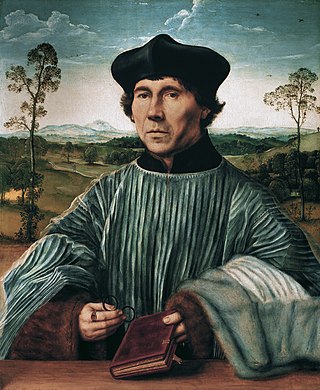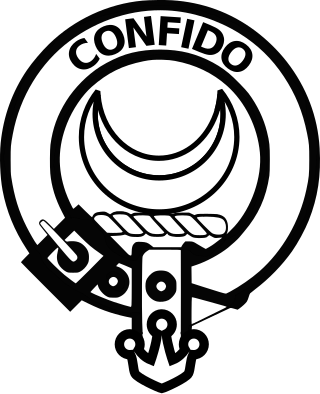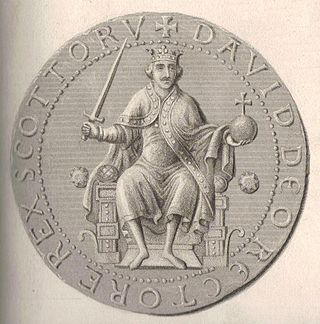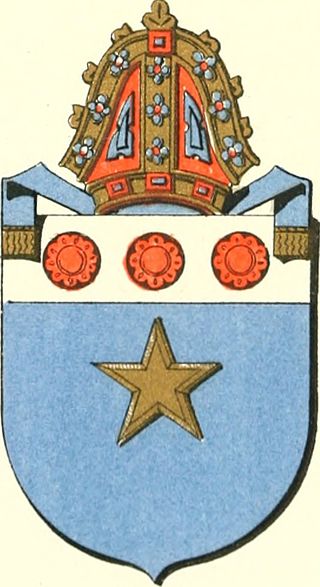Related Research Articles

Stephen Gardiner was an English Catholic bishop and politician during the English Reformation period who served as Lord Chancellor during the reign of Queen Mary I and King Philip.

Dryburgh Abbey, near Dryburgh on the banks of the River Tweed in the Scottish Borders, was nominally founded on 10 November (Martinmas) 1150 in an agreement between Hugh de Morville, Constable of Scotland, and the Premonstratensian canons regular from Alnwick Abbey in Northumberland. The arrival of the canons along with their first abbot, Roger, took place on 13 December 1152.
The Bishop of Dunkeld is the ecclesiastical head of the Diocese of Dunkeld, one of the largest and more important of Scotland's 13 medieval bishoprics, whose first recorded bishop is an early 12th-century cleric named Cormac. However, the first known abbot dates to the 10th century, and it is often assumed that in Scotland in the period before the 12th century, the roles of both bishop and abbot were one and the same. The Bishopric of Dunkeld ceased to exist as a Catholic institution after the Scottish Reformation but continued as a royal institution into the 17th century. The diocese was restored by Pope Leo XIII on 4 March 1878; it is now based in the city of Dundee.

Andrew Forman was a Scottish diplomat and prelate who became Bishop of Moray in 1501, Archbishop of Bourges in France, in 1513, Archbishop of St Andrews in 1514 as well as being Commendator of several monasteries.

Robert Reid was Abbot of Kinloss, Commendator-prior of Beauly, and Bishop of Orkney. He was born at Aikenhead in Clackmannan parish, the son of John Reid and Elizabeth Schanwell. His formal education began in 1511 at St Salvator's College in St Andrews University under the supervision of his uncle, Robert Schanwell, dean of the faculty of arts. Reid graduated in 1515 and by 1524 was subdean at Elgin Cathedral where, by 1527, he was Official of Moray. Thomas Chrystall, the abbot of Kinloss, chose Reid as his successor in 1526. In 1527, as abbot-designate, he attended the court of Pope Clement VII on abbacy business. While returning via Paris in 1528, Reid met the Piedmontese humanist scholar Giovanni Ferrerio who accompanied him back to Scotland. Following Chrystall's resignation in July 1528, Reid was blessed as abbot in September and received the Priory of Beauly, in commendam, in 1531. In that same year, Ferrerio left the court of James V to join Reid at Kinloss as tutor to the monks of both Kinloss and Beauly. Reid held many offices of state between 1532 and 1542 including ambassadorial roles to England and France and as a senior law official. He considerably improved the external and internal fabric of both monasteries in 1538.

The Abbot and then Commendator of Melrose was the head of the monastic community of Melrose Abbey, in Melrose in the Borders region of Scotland. The abbots of the earlier Northumbrian foundation from Lindisfarne are not included here. The second abbey was founded in 1136 on the patronage of David I, King of Scots, by Cistercian monks from Rievaulx Abbey, Yorkshire. Control of the abbey was secularized in the 16th century and after the accession of James Stewart, the abbey was held by commendators. The last commendator, James Douglas of Lochleven, resigned the abbacy to William Douglas, 6th Earl of Morton in December 1606, and the abbey itself to the king in 1608. The abbey was then erected into a secular lordship for viscount Haddington, John Ramsay, who in 1609 was created "Lord Melrose". Lochleven however resumed the title of commendator in 1613 until his death in 1620.
Jocelin was a twelfth-century Cistercian monk and cleric who became the fourth Abbot of Melrose before becoming Bishop of Glasgow, Scotland. He was probably born in the 1130s, and in his teenage years became a monk of Melrose Abbey. He rose in the service of Abbot Waltheof, and by the time of the short abbacy of Waltheof's successor Abbot William, Jocelin had become prior. Then in 1170 Jocelin himself became abbot, a position he held for four years. Jocelin was responsible for promoting the cult of the emerging Saint Waltheof, and in this had the support of Enguerrand, Bishop of Glasgow.
Enguerrand was a twelfth-century bishop of Glasgow. He had previously been Archdeacon of Teviotdale, and had served king Máel Coluim IV as Chancellor of Scotland between 1161 and 1164. He was elected Bishop of Glasgow on Sunday, 20 September 1164, and consecrated on 28 October at the hands of Pope Alexander III himself in Sens, France, where the Pope was then resident. He did not return to the diocese until 2 June 1165. Although he resigned the position of Royal Chancellor upon election to the bishopric, there is charter evidence that he once again became Chancellor in the reign of King William the Lion, probably in the year 1171. Notable actions of his episcopate included, probably on the request of his friend Jocelin, then Abbot of Melrose, the opening of the tomb of the emerging saint Walthoef. He died on 2 February 1174.
Robert Blackadder was a medieval Scottish prelate, diplomat and politician, who was Abbot of Melrose, Bishop-elect of Aberdeen and Bishop of Glasgow; when the latter was elevated to an archbishopric in 1492, he became the first ever Archbishop of Glasgow. Blackadder died while en route to Jerusalem on pilgrimage.

Durie is a Scottish family of the Scottish Lowlands, not a Scottish clan as sometimes reported.

The Prior, then Abbot and then Commendator of Dunfermline was the head of the Benedictine monastic community of Dunfermline Abbey, Fife, Scotland. The abbey itself was founded in 1128 by King David I of Scotland, but was of earlier origin. King Máel Coluim mac Donnchada had founded a church there with the help of Benedictines from Canterbury. Monks had been sent there in the reign of Étgar mac Maíl Choluim and Anselm had sent a letter requesting that Étgar's brother and successor King Alaxandair mac Maíl Coluim protect these monks. By 1120, when Alaxandair sent a delegation to Canterbury to secure Eadmer for the bishopric of St Andrews, there is a Prior of the Dunfermline monks by the name of Peter leading the delegation. Control of the abbey was secularized in the 16th century and after the accession of James Stewart in 1500, the abbey was held by commendators. In the second half of the 16th century, the abbey's lands were being carved up into lordships and it was finally annexed to the crown in July, 1593.
The Abbot of Dundrennan was the head of the Cistercian monastic community of Dundrennan Abbey, Galloway. It was founded by Fergus of Galloway in 1142. Dundrennan was a large and powerful monastery in the context of the south-west. It became secularised and protestantised in the 16th century. In 1606 it was finally turned into a secular lordship in for John Murray of Lochmaben, afterwards earl of Annandale.
The Abbot of Tongland was the head of the Premonstratensian monastic community of Tongland Abbey in the historical county of Kirkcudbrightshire in Dumfries and Galloway. The following is a list of abbots and commendators:

Historical treatment of David I and the Scottish church usually emphasises King David I of Scotland's pioneering role as the instrument of diocesan reorganisation and Norman penetration, beginning with the bishopric of Glasgow while David was Prince of the Cumbrians, and continuing further north after David acceded to the throne of Scotland. As well as this and his monastic patronage, focus too is usually given to his role as the defender of the Scottish church's independence from claims of overlordship by the Archbishop of York and the Archbishop of Canterbury.
Donald Campbell was a 16th-century Scottish noble and churchman. He was the son of Archibald Campbell, 2nd Earl of Argyll and Elizabeth Stewart, daughter of John Stewart, 1st Earl of Lennox. From 1522, he was a student of St Salvator's College, at the University of St Andrews. After graduation, he became a cleric in his home diocese, the diocese of Argyll.

George Durie, abbot of Dunfermline and archdeacon of St Andrews, son of John Durie of Durie in the county of Fife, and brother to Andrew Durie, bishop of Galloway, was born about 1496. From 1527 till 1530 he acted as judge and executor of the monastery of Arbroath. During this same period he assumed the title of abbot of Dunfermline, and discharged some of the duties of that office under the direction of his uncle, Archbishop James Beaton, the actual titular, on whose death in 1539 he was promoted by James V to the full dignity of the office.

Gilbert was a 13th-century Cistercian monk, abbot and bishop. His first appearance in the sources occurs under the year 1233, for which year the Chronicle of Melrose reported that "Sir Gilbert, the abbot of Glenluce, resigned his office, in the chapter of Melrose; and there he made his profession". It is not clear why Gilbert really did resign the position of Abbot of Glenluce, head of Glenluce Abbey in Galloway, in order to become a mere brother at Melrose Abbey; nor is it clear for how long Gilbert had been abbot, though his latest known predecessor is attested last on 27 May 1222. After going to there, Gilbert became the Master of the Novices at Melrose.
Odo Ydonc was a 13th-century Premonstratensian prelate. The first recorded appearance of Odo was when he witnessed a charter by Donnchadh, Earl of Carrick, on 21 July 1225. In this document he is already Abbot of Dercongal, incidentally the first Abbot of Dercongal to appear on record.

David Arnot was a Scottish prelate of the Catholic Church. He was the Bishop of Galloway (Scotland) from 1509 to 1526. He was from the Arnot family of Arnot, Fife.
Henry Wemyss was a prelate from the 16th century Kingdom of Scotland. He appears in the sources in the bishopric of Galloway for the first time in 1517, and rose to become Bishop of Galloway in 1526, a position he held until his death in 1541.
References
- . Dictionary of National Biography . London: Smith, Elder & Co. 1885–1900. [1]
- Attribution
![]() This article incorporates text from a publication now in the public domain : "Durie, Andrew". Dictionary of National Biography . London: Smith, Elder & Co. 1885–1900.
This article incorporates text from a publication now in the public domain : "Durie, Andrew". Dictionary of National Biography . London: Smith, Elder & Co. 1885–1900.
- ↑ This article lists the following in its citations: State Papers, Henry VIII, vol. iv.; Vatican Papers, Caligula B. vi. 420; Brunton and Haig's Senators of the College of Justice, p. 68; Keith's Scottish Bishops, p. 278.
